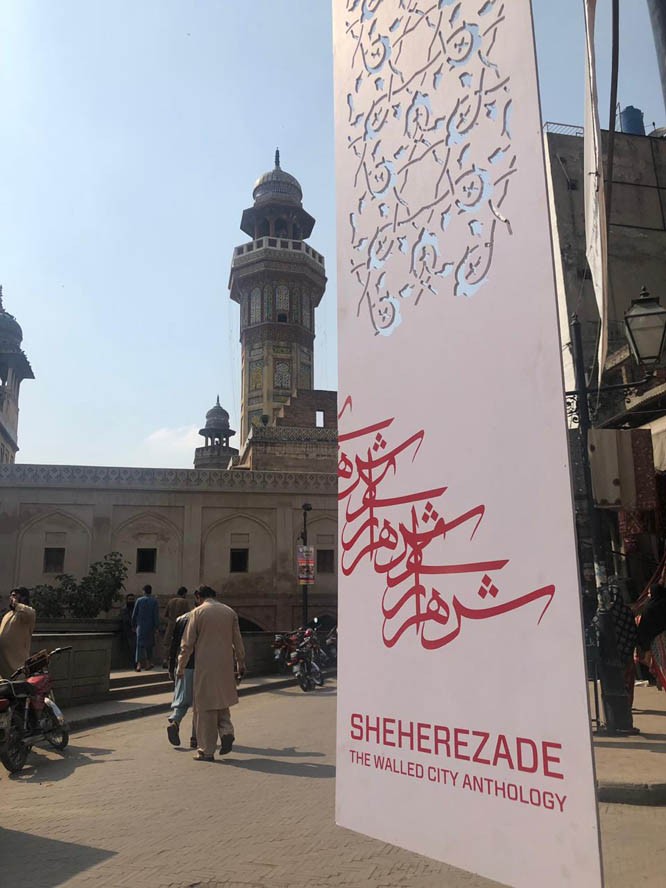
‘Shehrezade: The Walled City Anthology’ re-imagined the stories that have moulded and shaped Lahore, through art works conceptualised and installed by artists, craftspeople, and designers from Pakistan and abroad

Quite like the legendary Persian queen Sheherazade in One Thousand and One Nights (also titled, Alif Laila), who lived to tell stories to the Sassanid king of the times, the Walled City of Lahore is privy to fables, odes, and mysteries gathered over centuries. Mythology has it that Lahore was named after Lava, son of the Hindu god Rama, who supposedly founded the city. (A vacant temple inside the Lahore Fort is dedicated to Lava.) Historical books say the city’s early rulers were (successively) the Jains, Hindus, Buddhists, Mughals, Sikhs, and the British. During these periods, it endured war and plunder, whip and lash. The Mughals clothed it in thick walls and thirteen gates.
Lahore has continued to enchant both the rulers and the ruled. Its history has been retold in the verses of Madho Laal Hussain and Bulleh Shah, Iqbal, and Faiz, not to mention in fiction -- old as well as new -- by Manto and Ashfaq Ahmed and many, many more literary writers of stature. No wonder, when a mega arts event, titled ‘Shehrezade: The Walled City Anthology,’ commenced on March 16, with a view to re-illuminating the stories that moulded and shaped Lahore, it was bound to make headlines.
Jointly hosted by the British Council Pakistan, Numaish Karachi-Lahore, the Walled City of Lahore Authority (WCLA), and Mad Lab (UK), the "urban intervention" featured works that had been conceptualised and installed by artists including -- but not limited to -- Affan Baghpatti from Indus Valley, Karachi; Asa Calow, a "creative technologist and civic hacker" by admission, from Manchester; Lahore-based Noor Ali Chagani; and Dan Hett, a digital artist from UK -- and performers like Kauser Ali, Muzammil Ashraf, A Hafeez, Shehzad Khaleel, and Suraj Khan; and craftspeople, and designers from Pakistan and abroad.
The artists created projects that played on and were invented from "the materials, motifs, and mysteries of the inner city in a conversation that fuses the digital realm with some of the more tangible aspects of its sacred heritage."
The art installations, musical performances, and workshops unspooled along the Royal Trail, stretching from Delhi Gate to Lahore Fort. Residents, both of modernised Lahore and the neighbouring mohallas, nosed through congested markets, dodging scooter rickshaws, into winding gullies that slice open in courtyards, to be greeted by illustrations of the heritage, sacred geometry, local industry, and visual culture of ‘Androon Sheher’ (interior city).
In his art work, Baghpatti excavated memories of household items -- sarota (betel nut cutter), katori (metal cup), surmey daani (vessel for kohl), and dibya (small container) -- that have fallen into disuse and become outdated. Naveed Saeed submerged the air in scents from a thousand splendid flowers through floral installations inspired by royal gardens.
Through short films and long qwaalis, Shahzia Sikander’s 26 Distruption as Rapture and Hast-o-Neest’s Sufi Deen Muhammad, the event managed to get the Lahoris drink deeper in the Sufi tradition that has for generations plucked at their heartstrings. And, as the audience made their way out of the Sooraj Singh Mazar, they encountered digital installations that fused authentic Islamic geometric design patterns with 3D photogrammetry, thereby creating compelling, large-scale, interactive works.
The said instillations not only demonstrated the contrast between the temporal and spatial landscapes inside the Walled City and beyond but also inspired the viewers to ponder the place and purpose of ancient traditions in the expanding technocratic culture.
A few kilometres from the Delhi Gate, the Wazir Khan Mosque formed the heart of the event, pumping a bevy of people into the winding alleys that branched from it. As unsuspecting spectators squeezed through the Patli Gali, they were caught off-guard by the looping letters from the poetry of Ustaad Daman, painted by visual artist Zahid Mayo. As Mayo said, his aim was "to lay before the audience the emotion and action that forms the foundation of Lahore."
As the visitors hummed, "Pray, tell me in the city of Lahore how many are there doors, and how many windows?" they could feel those subtleties in their dear city that has been silenced and forgotten in the rush of life.
In a city embellished with grand structures like the Badshahi Mosque and veiled in mausoleums, gardens, havelis, and hamlets, with billowing turrets and minarets piercing the azure sky, ‘Shehrezade: The Walled City Anthology’ proved to be an event that narrated a thousand and one stories of our traditions so that, like in the story of Alif Laila, it might survive another dark, heavy night.